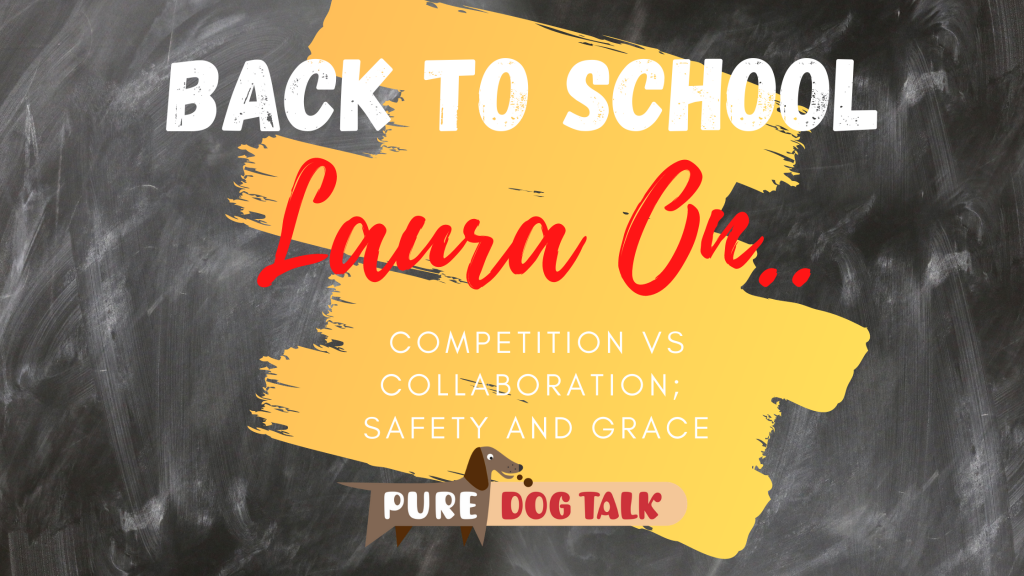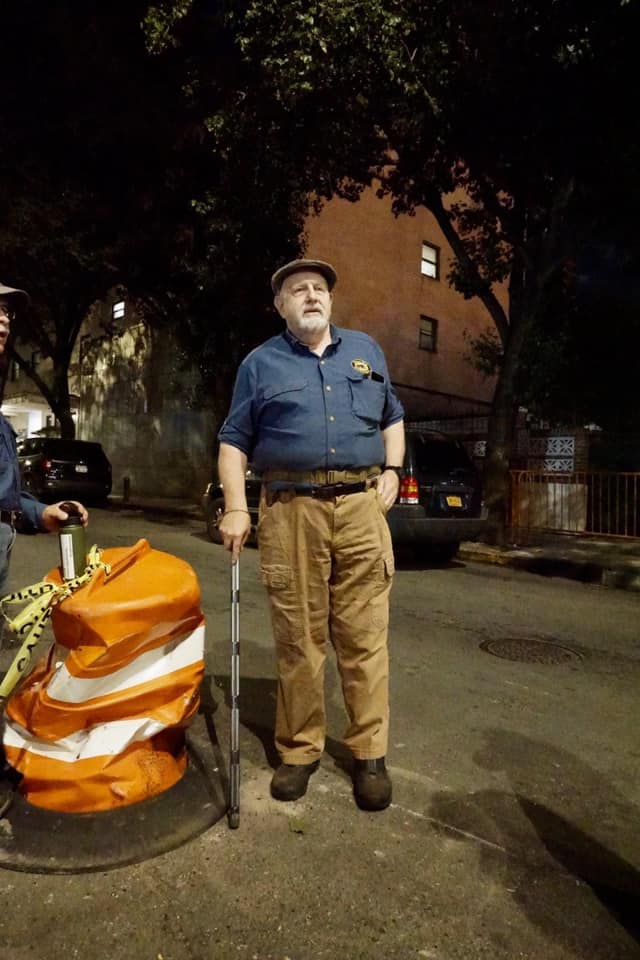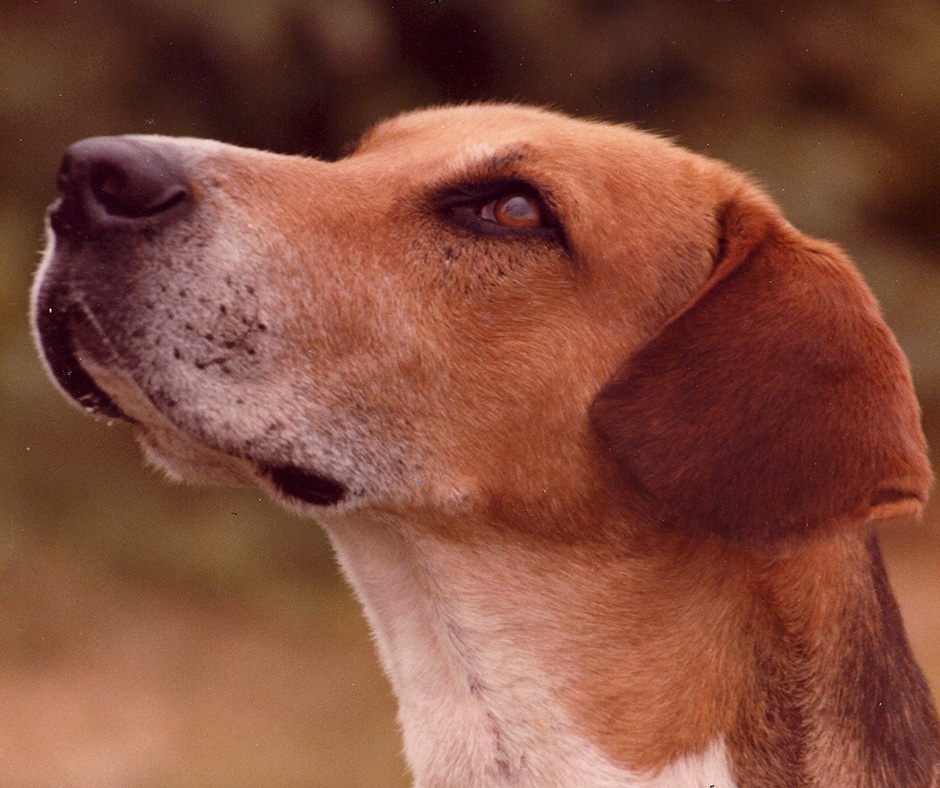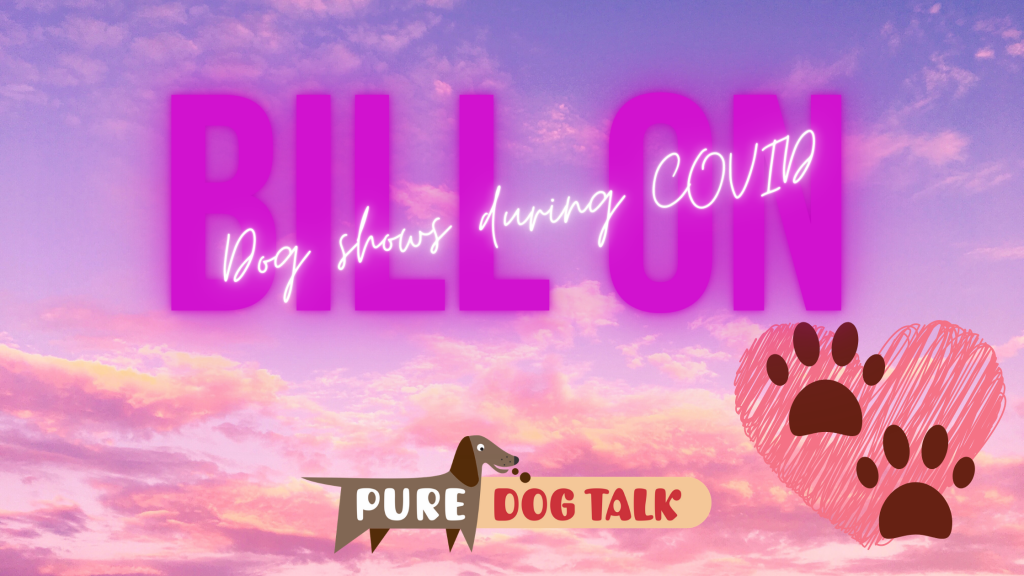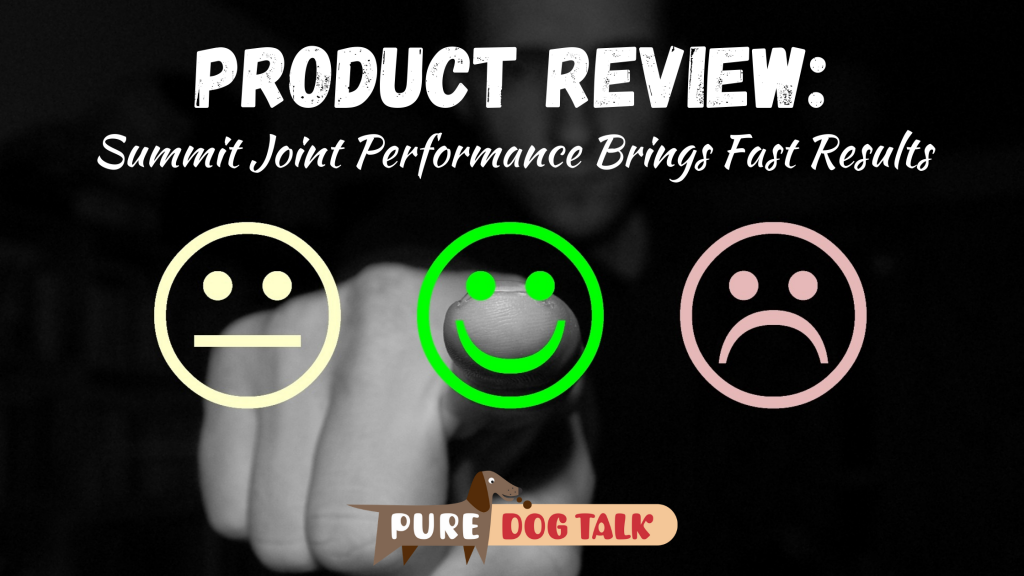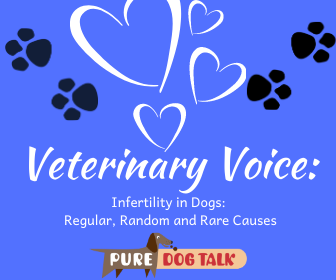Posts by Laura Reeves
440 – Successfully Collecting, Shipping and Freezing “Swimmers”
Successfully Collecting, Shipping and Storing “Swimmers”
Shannon and Sydney Stone from ICSB NorCal join host Laura Reeves for a detailed and educational conversation about collecting, shipping and freezing a stud dog’s semen, aka “swimmers.”
Mother and daughter share their vast experience with different extender media, freezing methods and tips and tricks for a successful collection of the stud dog.
Test drive extenders
For fresh chilled collections, Shannon strongly advocates for collecting a potential stud dog and doing a “chill test.” This enables the practitioners to save the semen in a variety of available media in order to be sure which one works best with the specific dog. Dogs are individuals and not all semen will survive in every media. It is critical to know this *before* that super important, exciting breeding that has been planned for years.
“It just basically boils down to finding the best media for your dog,” Shannon said. “There’s so many good medias on the market right now, it’s just what’s the best fit for your dog and what works best for you as a stud owner.
“Some of the best collections we see are ones where either the owner has a centrifuge or they took the dog to the vet and the collection is centrifuged and we’re only getting that sperm rich fraction added to the media.
“Kind of a rule of thumb that we’ve seen is, no matter what media you’re using, you can expect that … the loss of integrity to be about 20% per day that you’re holding a sample. So say you get a sample in on Friday or Saturday but the bitch really isn’t gonna be ready to breed til like Monday or Tuesday. We can check the semen and if we need to add a little bit, as long as we know what media was sent in, you can sometimes add a little fresh media to perk it up.
“What we say to our clients that are going to be shipping basically … a sample is always better in the bitch than in the box.”
Pellets vs straws
Frozen semen is stored in one of two methods. As “straws,” the original method developed by cattle breeders, often called “cattle straws” and “pellets” the method developed originally by ICSB. Sydney recommends, again, a freeze test to be sure which method is best for the individual stud dog.
The primary importance, Shannon noted, is to work with a veterinarian who is accustomed to the type of freezing method chosen. Thawing pellets and straws is two completely different processes. Using the wrong thaw method for the type of frozen semen will kill it immediately.
Collection Tips and Tricks
Technique, a teaser bitch and a relaxed stud dog are the keys to success, the team agreed.
“You have to know your dog and kind of change things up to accommodate him,” Shannon said. “It’s not one size fits all.”
Listen to our previous stud dog series with Shannon and Sydney here, here, here and here.
439 — Throwbacks: Competition vs Collaboration; Safety and Grace
Throwbacks: Competition vs Collaboration, Safety and Grace
Laura throws back to 2017 As the Wheels Turn columns touching on big topics during the final day of Back to School month.
You Win. I Lose.
Many of us involved with purebred dogs find purpose, excitement and enjoyment in the heat of competition. The adrenaline rush is part of the passion we bring to the game. Whether it is realized in the whelping box, in the show ring or in competitive performance venues. It becomes ingrained deep in the grooves of our brains…. Winning is good. Losing is bad.
That’s fine as far as it goes.
But…
Sometimes the passion morphs and becomes something altogether different. The “If You Win, I Lose” mindset is the root of many evils in our fancy. It applies to everything from jealousy over another exhibitor’s win to the fiefdoms of kennel clubs. We encounter it in the *expectation* that any friendly overture has an ulterior motive.
As a whole and with exceptions in emergencies, we are not a cohesive group. Number one. First. Best. Foremost. Record-setting. These are our golden idols and, too often, we guard them viciously.
But that “dog in a manger” attitude serves only to divide and conquer our fancy.
How does it hurt you to help someone else? What harm to have two good dogs, ideas or events? What if we celebrate, support and cheer on others who are doing well or doing good?
Teach the newbie. Help the youngster. Support someone else who has a good dog, a good idea or an exciting plan. What’s the worst possible thing that could happen? That you wouldn’t be the best? The point of the exercise to challenge ourselves to continue to improve — our breed, our skills, our knowledge. The only way that will happen is if someone comes along with a better mousetrap, as they say, and we have to improve on our design.
Ours is a tiny microcosm of the real world. We would do well to remember that making it smaller with petty squabbling does nothing more than weaken our ability to resist outside forces working hard to squash us all like bugs. Anybody read the AVMA proposal about “regulating breeders”? I highly recommend Bill Shelton’s article in the June 6 “Dog News Magazine” for a bit of perspective.
Let’s make a conscious decision to see others’ success as the same as our own. Because then, the purebred dog fancy becomes a powerful force for good in the world. When you win, we ALL win takes us to an entirely different level of influence. Whether in legislative matters or in creating an appealing and exciting sport which draws participation and builds our future from within.
Winter wonderland
Traveling to winter shows can be a little dicey (heck, in some parts of the country questionable driving weather lasts until May!). Ya’ll down there in Florida, just be careful of the weather envy being directed your way.
I can remember driving to the St. Paul, Minn. shows when I lived in Nebraska. Driving on I-80 looking at *hundreds* of cars literally upside down on the side of the road before I decided it was time to pull over and stop somewhere. Or driving home from Chicago and all of the sudden the water on the antenna in the RV wasn’t dripping anymore and the road was freezing around me…
In the dog fancy, we sometimes have to make choices. Decisions that should be easy in terms of safety first are often questioned … But, I could win! But, I could starve! But, but, but….
In the Pacific Northwest we don’t normally get hammered with the type of weather other parts of the country deal with routinely. Snow, ice, and dangerous roads. Here, sadly, we are often poorly equipped to deal with it… snow plows, de-icer, sand and salt being foreign language in the land where it never (well almost) gets above 80 degrees (F) or below 30…
I personally missed out on Palm Springs a few years back due to weather. A good friend (another handler) chose to cancel out on the Puyallup shows rather than fight through sheets of ice on the roads between here and there.
As we speak, people are stranded, the freeway closed for ice storms. Flights get canceled and judges can’t get out. Inevitably, every 5 years or so, even the Garden has such a horrible blizzard people can’t get there … one reason some folks were thrilled to see Westminster Kennel Club moved to June this year.
So, I guess my point is this. When and what makes the call for you? Either professional or amateur. At what point is it not worth it?
When I announced to my social media (clients, friends, etc) that I wasn’t going to make it to that Palm Springs show, there were lots of supportive comments (at least publicly). Then I saw this note from a former boss, friend and mentor… I was quite startled at first, but it brought tears to my eyes as I read along.
“Oh for goodness sake Laura. I thought I taught you better than this. Toughen up girl.
You need to let the “Dog Show Addiction” take over your judgement. Screw with your safety let alone the dogs safety the(re) is a Dog Show to get to.
“Does it really matter if the end result is you end up in a ditch freezing? Maybe you just lose a dog or two. No matter someone will tow you out and you still may make the last day it’s the best judge for that last point anyway. As long as you don’t have a head on crash with a Semi that wipes you and the dogs out which God Forbid might break a major. At least they will say you tried to make it. …”
While the comment ended with praise for my decisions and generally glowing character, the initial shock to my system was I could actually **hear** other people saying *exactly* this… And meaning it.
In what world is a dog show worth risking our lives or our dogs’ lives? (PS I’m not even touching COVID, but it does have some bearing here….) The older I get, the more risk averse, I suppose.
It all goes hand in hand with when is it too hot in the summer to show dogs outdoors, and so on.
I guess, for me, the decision is about the dogs. Will they be safe? Is there a better than the average “every time I drive somewhere an idiot could crash into me” chance of disaster? We band together to watch each other’s backs, report road hazards, caravan, cover dogs, offer safe stopping places and otherwise be of assistance. But in the end, each of us has to make these decisions for ourselves and for the dogs in our care.
Let’s continue to support one another as we all do the very best we can do, with what we have to work with. To my friends, cohorts and companions, I bow to your strength and endurance and enduring humor in the face of what sometimes seems overwhelming adversity.
Seven virtues
Let’s all try to practice the grace we’d like to receive for our own failings…
“In the Catholic catechism, the seven virtues refers to the union of two sets of virtues. The four cardinal virtues, from ancient Greek philosophy, are prudence, justice, temperance (or restraint), and courage (or fortitude).
The three theological virtues, from the letters of St. Paul of Tarsus, are faith, hope, and charity (or love). These were adopted by the Church Fathers as the Seven Virtues.” — Wikkipedia
The beautiful part of this topic is it strikes to the core of why so many of us have stayed loyal to what can be a tough sport. I know there are folks out there who have never experienced some of these aspects of the fancy. It makes me sad. I can only offer the input of long-time fanciers. And suggest that, as in anything, we get what we give.
Courage
From reader Maryke Nau, Ridgefield, WA:
“One of the seven virtues that struck me for the dog show world based on many of the conversations I have been having with breeders was Courage, from a few different perspectives:
*Merely taking your beloved pet, the hours of time and money and raising, and asking somebody to give their objective opinion is courageous, especially when the “judge” rarely has to give any reasoning, you just have to suck it up and take the opinion.
*No other sport has amateurs competing against professionals. These owner-handlers who do this as a hobby and compete against someone that makes it their entire life is nothing short of courageous.
*Many breeds face challenges with clearances and health issues, but it is the courageous breeders that are public for the sake of learning and willing to address their issues, even it means starting over. When somebody says they don’t have any health issues, it merely means they haven’t been honest and courageous enough to look.”
Charity
From reader Linda Ercoli, Southern California:
This organization is perhaps the quintessential “heart” of our tribe. For every story of people helping people on a purely personal level, and they are legion,TTL multiplies the effort and takes it to a whole new level.
In the 20 years since its inception, TTL has paid out $3,879,017 to members of the fancy who were desperately in need.
From the TTL website:
“Take the Lead was founded in 1993 as a not-for-profit foundation under Section 501 (c)3 of the Internal Revenue Code dedicated to provide direct services, support and care for all qualified participants in the sport of dogs who suffer from the devastating realities of life-threatening or terminal illnesses.
The AIDS crisis opened our eyes to the many ruthless illnesses that were
challenging us to our very core. Though we came together week in and week out to compete at shows and trials, to participate in club activities, to share knowledge and common interests, we had inadequate resources in any one place to take care of those in our community who so clearly needed our help…….
In 1995, we established a permanent restricted fund and determined that up to one half of each year’s net income would be placed in it. Already we have seen this seed investment become a substantial asset. It is our goal that one day the interest earned on this endowment will provide more than enough income to cover the expenses of everyone in our sport who qualifies for assistance.”
Learn more at http://takethelead.org/
Prudence
A reader emailed me early on in the publication of this column with commentary on the topic of professional handlers being too chummy with judges. One of the statements in this missive completely floored me. “We don’t know any judges.”
My first thought was, why not? They aren’t aliens! Volunteer for your all-breed club. Ring steward. Help with hospitality. Join a committee within your national or local breed club. Get involved in something larger than just yourself. When you have that background, inevitably you will wind up being judged by someone you know personally. Use common sense and be polite but reserved in your public interactions. Everyone has lines they won’t cross. My rule is, I will not show dogs to my close friends or former clients. It invites bad juju. On the other hand, I know lots of members of this tribe — from casual acquaintances, to breeders with whom I regularly interact on club business or have known for years, to former colleagues and competitors who have “aged out” of handling and are now judging. I have to respect that these folks will judge the dog on the day or I would be left with a very limited pool of people to whom I could show dogs.
Hope (and Faith)
Perhaps there is nothing more hopeful in the world than a new puppy. Years are spent planning a breeding. In the best of all worlds, you are creating dogs specifically designed to make the next breeding. Without fail, there is a flutter in your chest, a glimmer in your eye, a catch in your breath when they start opening their eyes and forming their own little personalities. Every step of the way, from the second the sack is broken at birth, through evaluation and placement, weeding out, testing, watching and waiting for the ONE, there is hope. I know a few denizens of the sport who bought the ONE, some even by accident. But as a breeder (long before I was a handler), the hope, faith and joy involved in a litter of new puppies is unparalleled. Hope, often as not crashed on the rocks of some fault, small or large. Faith that the next “twist” will do the trick. Joy when all those plans and blueprints (ie pedigrees); all the blood, sweat and tears of pain and happiness; all the anguish and anticipation, finally gel and you get, almost, the ONE. Then, you try, again, to perfect it.
Justice (and Temperance)
Never let it be said there is no justice in this sport. I see it every weekend. The underdog wins far more often than the popular myth would have you believe. They just don’t talk about it as much. I love to watch talented breeder-owner-handlers. People who have studied and perfected the art of their breed. People who have bred, trained, conditioned and groomed their dogs to the nth degree. They routinely beat me. I find those people and learn from them!
These are competitors who practice temperance. They do not follow fads and trends. They doggedly (bad pun) breed to the standard, whether it fits with the current fashion or not. These people avoid excess in their breeding programs, in their advertising and in their behavior.
It matters not whether the breed is Basenji or Pug or Clumber Spaniel or Akita. Patience is part of this virtue. Breeders, owners and handlers who are building on a solid foundation for the future they envision, even if it is different than the one I would choose, will always be my heroes.
438 – Richard Reynolds – Rat Hunter of Manhattan
Richard Reynolds – Rat Hunter of Manhattan
Richard Reynolds joins me for part two of our conversation. This time we’re talking rat hunting with Terriers in New York City.
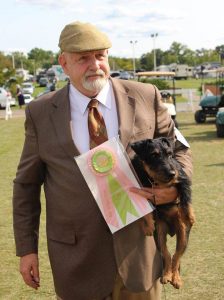
Richard Reynolds with a Jagd Terrier, shown in FSS at Open Shows.
“Quite fairly there was never a transition (from hounds to terriers),” Reynolds said. “I was always interested in hunting the terriers. We don’t have as many Fox in the United States as they do in England … and you had to work a little harder. Bringing up the terriers and putting the terriers to ground was always a part of our Fox hunt.
“When I left the pack, I wanted a purebred terrier that I could show. Somebody slipped me into a low mileage used Norfolk terrier and that suited me pretty good. But I didn’t know whether it could hunt or not. A few years later and a little experience and a few Norfolks later, we proved they were damn good hunters. In fact, the best terrier that I’ve ever had to this day remains one particular Norfolk.”
Reynolds’ rise to fame as the Rat Hunter of Manhattan started at a dog show in Liberty Park at the base of the Statue of Liberty. Rats had overrun one of the handlers’ setups and he turned his Norfolk loose to do its job. The park superintendent happened to see this feat. The rest, as they say, is history.
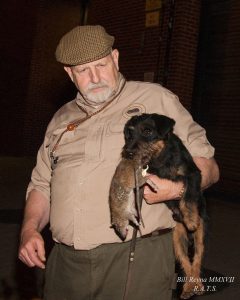
Jagd Terrier with Reynolds and one less rat on the streets of Manhattan.
“If I tell you that my dog is a good rat catcher, you won’t care,” Reynolds opined. “If a rat is headed to run up your pant leg and my dog stops it, you’ll have a lot of respect for that fuzzy little critter down there. So that’s exactly the way we’re trying to make our point.
“We’re all about an idea. That idea is preserving breed type through maintaining the actual function of the dog. You can simulate all these things but you can’t replicate the actual deed of hunting or ratting or whatever. It’s different. It’s about the dogs but don’t tell anybody because we get an awful lot of good press on the fact that we’re killing rats.
“We can’t show purebred dogs to the media. They don’t care. Dead rats are a big seller. We have media with us (nearly) every night that we go out. We’ve had a lot of media. But that’s our little way of selling purebred dogs to the public.
“We’re doing it for the sake of the dogs. There’s no money here. All sport is ruined as soon as you monetize it. So we don’t charge to hunt. Our members occasionally cough up $5 each time they hunt, but more often than not they forget to pay it and we forget to collect it. So it’s kind of a thing for the dogs, by the dogs and of the dogs. A good night is when the dogs work well together. A bad night is when we don’t get anything.”
Reynolds has been instrumental in setting up a training ground in southern New Jersey. The primary purpose of which is running AKC earthdog tests.
“We use it as a basic training ground for terriers and dachshunds,” Reynolds noted. “It’s not the same thing (as street hunting). Once they get through the earth dog program there’s a lot of on the job training but it’s a starting point. The sport of AKC earthdog or den trials or Jack Russell terrier Association go to ground is kind of diminished in recent years. We use it for training Street dogs but really what we’re trying to do is rejuvenate this sport in and of itself of earth dogs and den trials.”
437 – Richard Reynolds on Foxhounds and Favors
Richard Reynolds on Foxhounds and Favors
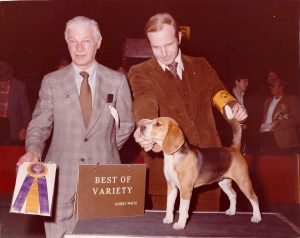
“Westminster 1977. BoV under Peter Knoop was 13” Ch. Englandale’s Crestwood Star. I sold her as a pet, but her owner believed that she could do anything and pushed me to show her. She not only finished her title, and won the variety at “the World Series of Dogdom”, she also had several obedience titles.”
Richard Reynolds is joining us today. This is the first part of a two-part episode. We’re going to talk about rat hunting and foxhounds and all kinds of fabulous historical stuff, because he is a brain trust of all things history in purebred dogs.
Reynolds said his involvement in purebred dogs “started from a National Geographic magazine. I was a young lad in his early teens and I came upon a National Geographic magazine that had an article Westminster, the World Series of Dogs” circa 1949.
“All of my colleagues had Playboy magazine hidden under their mattresses and I had National Geographic,” Reynolds said, “not for the same purpose of course.”
Reynolds said he acquired his first Beagle “for the princely sum of $35 from a gentleman who hunted them and, as they say, the rest was history.

“The hound was Mr. Stewart’s Cheshire Federal, a gift to me from Nancy Penn Smith Hannum, MFH. There weren’t any other AKC English Foxhounds around, so we finished him the hard way…by winning groups. I believe he was the second AKC Ch. English Foxhound.”
“The first Beagle fell somewhat short of being a show dog, but the next one was a show dog. It cost a great deal more than $35, although I’m not sure it was worth much more. That kind of got me started with the dog showing thing.”
Reynolds’ focus has always been on preserving breed type through concentration on performance ability. He was a Master of Foxhounds with the only dual registry recognized hunting pack. His Old English hounds won a group at Westminster, many Bests in Show, many Large Pack classes at hound shows and the occasional Grand Championship.
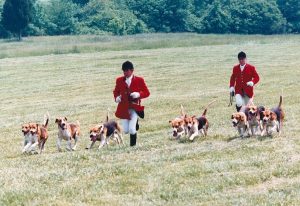
“These were my hounds in the Five Couple class at the Virginia Hound Show some years ago,” Renolds noted on social media.
Most important, Reynolds noted, each hound hunted a regular three day a week schedule.
Comparing the English and American Foxhounds, Reynolds notes, “The old English Foxhound is heavier, larger. Level top line. Picture, if you will, a bulldozer on feet. The American foxhound is lighter, leggier, has a slight rise over the loin to give it speed. It’s of course descended from the English Foxhound, but it’s not exactly the same.
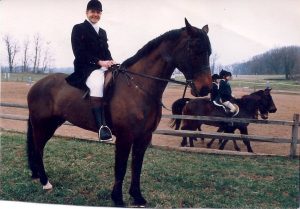
“When one is a visitor, hunting with another recognized pack, it is courteous to wear a black coat rather than scarlet with your home hunt colors. This was on such an occasion with my ex-three day eventer, Eastwick.”
“They both have their purposes and, like all of the hounds and terriers, that purpose is directly related to the country, the land where the dog hunts and works. American foxhounds are suited to the wide open spaces in the United States and the English are suited to the Gorse hedges and stone walls and whatever of England. We found them very useful in Pennsylvania where I’m at because we have a wonderful agricultural phenomenon known as the multiflora rose.”
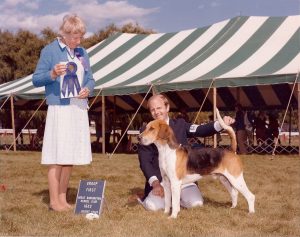
Ch. Mr. Stewart’s Cheshire Winslow. In 1983 Winslow was number one amongst all hound breeds and in 1984 won the hound group at Westminster.
Reynolds’ most famous dog was Ch. Mr Stewart’s Cheshire Winslow.
“He hunted pretty good and he was a reasonably good stud dog,” Reynolds quipped, “but he was a really good show dog. He was the top of all hound breeds in 1983, won the Quaker oats award for the top winning hound, and then he kind of walked out of Westminster in 1984 with the hound group. So having done that, we figured that we were duty bound to get him back to the hunt field the following morning. So he won the group at Westminster on Tuesday night, and hunted Fox from horseback on Wednesday morning.”
Reynold’s wry, self-deprecating humor is a treasure to the dog community. Enjoy this episode and join us next week for our conversation on terriers.
436 – 10 Tips to Ease Your Journey in the Dog Show World
435 – Hot Topic: Are we “protecting our breeds into extinction”?
434 – Bill McFadden on Dog Shows During Covid: Safety First
Bill McFadden on Dog Shows During COVID: Safety First and Other Observations
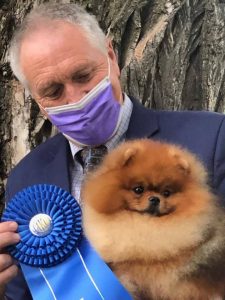 Professional handler Bill McFadden has attended shows across the country in the four months since the “Learning Cluster” in Oklahoma. A two-time Westminster Kennel Club BIS winning handler, lifetime participant in the sport and all-around good guy, McFadden’s observations, notes on what worked and self-appointed “bathroom police” stories provide a glimpse into this unprecedented time in American history.
Professional handler Bill McFadden has attended shows across the country in the four months since the “Learning Cluster” in Oklahoma. A two-time Westminster Kennel Club BIS winning handler, lifetime participant in the sport and all-around good guy, McFadden’s observations, notes on what worked and self-appointed “bathroom police” stories provide a glimpse into this unprecedented time in American history.
“My overview would be that I am proud of our community,” McFadden said. “I think that they’ve stepped up and either endured or participated in whatever protocol was established for each show. I hope it continues that way. I hope that we continue to be safe. I hope we get through this and maybe learn a few things about ourselves and our sport in the process.”
Host Laura Reeves commented that the silver lining of the year’s trying times is that we can “apply lessons from what we’re provided by the universe. You don’t get to pick (the circumstances) but you can pick how you respond to it.”
“Everybody just be safe and set your own limits for what you will or will not tolerate and stick to it,” McFadden added. “I actually have been impressed by people that step outside their comfort zone and say ‘you know, you’re standing too close.’ Some of the shows, the stewards actually will come up and say ‘could you guys spread out,’ ’cause we all kind of congregate during the groups. You kind of hang out while everybody else is being gone over. Old habits die hard. It wasn’t being defiant, it’s just you need someone to remind you.
“So, I’ve been really impressed by those actions by individuals and by clubs. Some of them do it in the most unbelievably gentle and kind way where you’re just like ‘oh gosh I’m so sorry’ … every once in a while there will be someone that’s a little snarky, but for the most part I think people have been doing a really good job.
“I will admit that I was nervous as I drove 24 hours to Oklahoma … I think everybody was. I know my assistant was. I was pleasantly surprised. Personally, I just thought that there might be a few resistant people that wouldn’t want to follow the rules that were set up. I was super impressed. I thought everybody complied. It’s definitely different showing with a mask on.
“…(P)articularly in the beginning, with the first few shows, we were just so happy to see each other. A lot of us hadn’t communicated so we weren’t really sure how our lives had gone and how are you surviving … initially I think there was a lot of that. I mean it was like going to a family reunion. We were just was so happy to see people … as it’s progressed, there’s people that we’ve seen several times, so it doesn’t feel like you’ve been away for so long.
“But I really think most people are just… we’re all in it together. We’re enduring it. We know we’re going to get through it and we’re helping each other out as much as we can. If there is one downfall, it’s really hard to control the social distancing after the show…”
Listen in as McFadden covers hotels, airplanes, COVID testing and more.
433 — Five Tips for Staying Motivated During Uncertainty
433 – Product Review: Summit Joint Performance Brings Fast Results
Product Review: Summit Joint Performance Brings Fast Results
Host Laura Reeves visits with Dorian Farmer and Rhonda Arza talk about Summit Joint Performance. This is a chondroitin product, used for years in Olympic horse circles, but now available for dogs and, hopefully, humans in the near future.
“This particular product was actually made to go into eyes, human eyes, during corneal lens transplant surgeries as an anti-inflammatory,” Summit Joint Performance founder Farmer said.
From the Summit Joint Performance website:
What is Summit?
- Summit is simply chondroitin 4 sulfate (C4S), suspended in sterile water. Summit was originally developed to use in human ocular lens transplant surgeries. Summit is the purest form of C4S available. Unlike other products, it has had all heparins and other potentially damaging molecules removed from the single C4S molecule. Summit is an all-natural product, not a synthetic created in the lab, nor polysulfated. Summit has an incredibly low molecular weight, and its small size allows it to penetrate barriers in the body, like joint capsules, much easier than other products. A large percentage of the molecules that make up tissues in the joints is C4S. Replenishing these structures with nature’s version of this important molecule, instead of synthetic lab creations that are over 100x the molecular weight, is of great benefit.
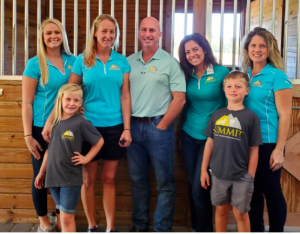
Dorian Farmer and the SJP team.
Farmer’s story of testing Summit on his personal “guinea pig” animals is inspiring.
“We injected Ultra on a Wednesday evening. At that point in time she couldn’t get up off the ground. By Thursday morning when we woke up, she was standing in our bedroom wagging her tail looking at me. She had got up off the ground by herself, into the bedroom and was waking us up. She could walk around the house. She could sit down. She could lay down and she could get back up. That was within 12 hours. By the following day she was trotting around the house and actually playing with me.
“(A couple days later I got a video of) Ultra chasing the golf cart at a dead run from the back pasture to the front pasture. It’s about 900 yards from one to the other. She lived for another year pain free because of it. That truly was the point where I knew that we had something that was incredible. She had been on all the pain relievers and all the other arthritic medication and everything else and nothing was touching it. One shot of this new product and saved her life. I mean, we were going to euthanize her….”
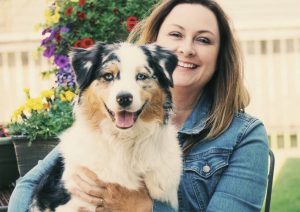
Rhonda Arza, SJP Vice President
Arza, Summit Joint Performance Vice President, shared her similar experience.
“I was a horse trainer for 28 years and one of the things that I knew was that I didn’t want to be a horse trainer for 29 years. So, I needed an exit strategy. Summit last November became a direct sales company. I had experience in the field, so I knew that direct sales was a way to make significant income and create an exit strategy not only for myself, but for other trainers who were looking to retire, get out, whatever they needed to do.
“When this came along, because of the level of sponsored riders that this company already had in place, like people were putting it in their $10,000,000 Olympic level horses, we had guys like McLain Ward (using the product), I knew that we had a product that was definitely something that I could talk about.
“I put it into my 20-year-old jumper and he just turned right around and acted like he was ten. I wanted to get into the dog space because we have performance dogs. My husband shows in rally and obedience and we have Australian Shepherds. Knowing that it was going to be turning over to oral (versus intramuscular injection) was going to open up the whole planet for us. Not only dog show people, but pet owners and people who have older cats and things like that.
“This is going to not only change the lives of so many pets, it’s going to change the lives of so many humans. Especially during this time frame where we’re not going to as many horse shows, we’re not going to as many dog shows, we’re in a little bit of a financial pickle. This is the answer to people’s prayers.”
“We all take glucosamine chondroitin supplements that we get in the grocery store,” Farmer noted. “They say ‘in six months you should start to see some results.’ I don’t do anything for six days if I don’t see results. I am a very instant gratification, transactional kind of guy. I’m going to do this, I expect to see results. That was what we saw with this. I didn’t have to wait six weeks or a month or two weeks, we saw results the next day.”
432 — Infertility in Dogs: Regular, Random and Rare Causes
Infertility Issues: Regular, Random and Rare Causes
Dr. Marty Greer, DVM joins host Laura Reeves for a wide-ranging conversation on the causes of infertility in our breeding bitches. From split seasons, ovarian and uterine cysts, to semen allergy and genetic incompatibility, we cover a lot of ground.
Marty was kind enough to provide the following “check list” of fertility issues to share with our listeners. Links to previous Pure Dog Talk podcasts on the topics noted are included in the underlined areas.
Why isn’t my female pregnant? What can I do about it?
by Dr. Marty Greer, DVM
You did your homework – and have the perfect bitch, in her best condition and found the ideal male to mate her to. Both of them have passed all of the health clearances recommended for your breed. They have the temperaments you are looking for and their traits are complimentary to one another.
You know the most common causes of apparent or actual pregnancy failure are:
- Poorly timed breedings
- Poor semen quality and/or quantity.
- Failure to maintain a pregnancy
Timing the breeding:
The timing of the breeding, based on progesterone levels (bred 2 to 3 days post-ovulation depending on semen type used), was just right. Most veterinarians recommend breeding 2 days after ovulation with fresh and fresh chilled shipped semen and 3 days with frozen semen. Ovulation is assumed to occur when the progesterone reaches 5 ng/dl (different units are used in other countries) with a range of 4 to 10 ng/dl. LH testing is also done in some clinics. LH, Luteinizing hormone, directly indicates ovulation, while progesterone is an estimation of ovulation. Progesterone is easier to measure and test as it can be done every few days, using human technology. LH requires daily testing and is canine specific.
Semen quality and quantity:
You know the stud dog had good quality and quantity semen – there was a semen analysis completed prior to shipping the semen. Your vet looked at it prior to inseminating your bitch and said the semen looked great, based on the sperm count (for a Bernese Mountain dog, the count should be 1 billion total), the morphology (shape and appearance of each sperm cell) and motility (how active and progressively motile it was on a microscopic evaluation).
Yet, she is not pregnant. Why? And if you try to breed her again, what can you do differently to improve the chances she will carry a litter to term?
First, we need to determine if she failed to conceive, failed to achieve fetal/placental implantation, or conceived and lost the litter. If you don’t have her ultrasounded, you won’t know if she failed to conceive or failed to maintain the pregnancy. A relaxin test or palpation is not adequate – these do not assess for fetal viability. This information is big piece of the puzzle. When you are trying to justify the decision to do an ultrasound, this is the best reason to do so – this is not the place to scrimp.
If the ultrasound shows no pregnancy, and the semen and timing were good, then causes for failure to conceive or failure for fetuses to implant should be explored. These include:
- Was there a Semen quality assessment?
- Was the sperm count low?
- Was there abnormal semen morphology? Was the semen stained and assessed by a veterinarian?
- Was there poor semen motility? The semen needs to be progressively normal.
- Was there poor semen longevity? Holding a small sample of semen in extended in the refrigerator and reassessing it 24 and 48 hours later can be useful.
- Was there timing failure? This is a good time to review the timing of the breeding.
- Did she complete her ovulation?
- Failure to complete the ovulation. Did the progesterone testing continue past 5 ng/dl? If not, she may have not had a complete ovulatory cycle.
- Cystic ovaries? An ovarian cyst can interfere with a complete ovulatory cycle.
- Split cycle? If she failed to complete her ovulation, she may have split her cycle and will come back into heat in the next 4 to 6 weeks.
- Failure of adequate semen deposition: Fertile sperm must reach a fertile egg.
- If this was a natural breeding, was there a tie? Was the breeding witnessed? Was there a normal length tie?
- If this was a vaginal AI, was the AI performed correctly with no spermicidal exposure. Some lubricants and reusable equipment can have spermicidal properties. Using all disposable supplies is recommended.
- Does the bitch have a defect in her reproductive tract? Structural abnormalities causing failure of semen passage from the vagina to the oviducts including male and female anatomical abnormalities.
- Do either the male or female have Brucellosis? Canine brucellosis is a bacterial disease that can be spread venerally and can cause sterility in the male or female as well as pregnancy failure and early neonatal death.
- Was the bitch exposed to Canine Herpesvirus? – This is a viral disease that can cause early or late fetal death as well as neonatal death. In the adult, Canine Herpervirus causes mild respiratory disease. During early pregnancy, the fetuses can die at any stage, causing apparent failure to conceive if it is contracted during early pregnancy.
- Does the bitch have a bacterial infection in the vagina or uterus? A low-grade metritis, not rising to the level of a pyometra can interfere with conception. The difficulty here is that even in 2017, we cannot identify what normal bacterial flora in the reproductive tract is.
- Did she have another bacterial or viral disease that are not yet well characterized?
- Does she have a systemic illness? Any disorder that causes a fever can interrupt a pregnancy. Did she have a complete blood panel test, checking for signs of infection or organ disease? Consider testing for Lyme disease, Anaplasmosis, and Ehrlichia before you breed.
- Failure of the ovary to maintain progesterone high enough to support pregnancy (hypoluteoidism) Rarely, a bitch will have the inability to keep her progesterone level high enough to maintain pregnancy. This can occur as early as day 14 of the pregnancy. Testing her progesterone level at her pregnancy ultrasound can be an important tool.
- Does the bitch have abnormalities in her uterine lining? Cystic endometrial hyperplasia and fibrosis of the uterus can prevent normal placental development.
- Is there genetic incompatibility? If there are fatal genes, conception with pregnancy failure can occur. Line breeding dogs with too little genetic diversity can lead to small or no litters.
- Was there inadequate maternal nutrition?
- Raw meat diets can contribute to an imbalanced nutritional plane. Micronutrients and macronutrients must be adequate to maintain pregnancy. Bitches require carbohydrates to maintain pregnancy as well as to lactate.
- Does she have parasites? Parasite migration can lead to placental failure. The stress of pregnancy can lead to latent parasites starting to migrate again. Using Fenbendazole from day 40 of pregnancy to day 14 of lactation can protect the fetuses from this condition.
- Was the bitch subjected to trauma? Blunt trauma can cause the placentas to fail.
- Was the bitch subjected to undue stress?
- Did the bitch receive anesthesia, or inappropriate drug or hormones? Many of these drugs can be toxic to developing fetuses. All drugs should be avoided during pregnancy unless required to save the bitch’s life.
- Is the bitch Hypothyroid? Low thyroid levels can contribute to pregnancy failure or failure to conceive. This is a rare cause of pregnancy failure but should be considered if the levels are profoundly low.
If no underlying cause for failure to conceive is found, surgical breeding may be considered to improve the chances of success at the next breeding. Some bitches will conceive pups when surgical breedings are used to deliver the semen directly into the uterine body.
If the ultrasound shows a pregnancy was achieved but not maintained, this can result in fetal resorption (prior to day 45 of pregnancy) or fetal death and/or abortion (fetal loss after day 45 of pregnancy). This rules out poor timing, poor semen quality, or failure of semen to pass to the oviducts as causes for infertility.
Causes of failure to maintain a pregnancy include (see descriptions above):
- Brucellosis?
- Herpesvirus?
- Bacterial infections in the uterus. Cultures should be taken and antibiotics used if bacterial disease is suspected.
- Other bacterial and viral diseases that are not yet well characterized.
- Failure of the ovary to maintain progesterone high enough to support pregnancy (hypoluteoidism). Serial progesterone levels should be run if hypoluteoidism is suspected.
- Uterine lining changes that interfere with maintained placental attachment.
- Inadequate maternal nutrition.
- Trauma, stress, anesthesia or drug and hormonal interference.
A complete history should be taken. Diagnostics should include testing for brucellosis and Canine Herpesvirus. Cornell’s Veterinary Diagnostic lab has a blood profile called the “Canine Abortion Panel. Your veterinary clinic can submit tests for this. It is best done with paired samples, drawn 3 weeks apart and submitted together.
The pregnancy can be monitored for viable fetuses with repeated ultrasounds. WhelpwiseTM can be used to manage high risk pregnancies. Antibiotics, progesterone and terbutaline may be indicated if uterine irritability is shown to be putting the pups at risk. These drugs help quiet the uterus and can keep the pups safely in the uterus until they reach full term.


